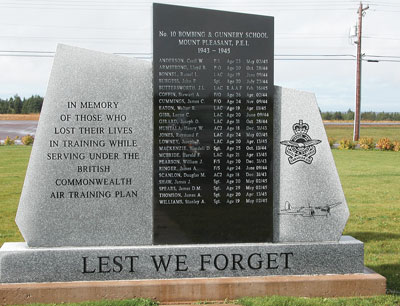
News
Glide Path: Saluting the efforts of the CATP
As summer fades and winter lurks behind dark clouds, we come across Remembrance Day.
October 31, 2012 By Paul Dixon
As summer fades and winter lurks behind dark clouds, we come across Remembrance Day. For some of us, it has taken a long time to gain an appreciation of what should be remembered and why.
 |
|
| Of the 22 who died at Mount Pleasant, there were more in their teens than over the age of 25. PHOTO: Paul Dixon
|
Our fathers and their generation went off to war and all too many of them didn’t come home. Out of a population of just over 11 million, more than 1.12 million Canadian men and women wore the maple leaf and more than 44,093 of them gave their lives, 17,101 of them while serving with the Royal Canadian Air Force (RCAF). I knew the stories of the RCAF in the Second World War and I even worked with a few veterans who didn’t talk much about their experiences. When they did talk, it was more often about the thrill of running a Model A Ford on 140-octane aviation fuel from Comox to Victoria, rather than exploits overseas.
It took me a long time to realize that the numbers in the first paragraph are only the tip of the iceberg. My wife and I were in Prince Edward Island in 2003, at the end of the tourist season. We drove up from Halifax to Summerside the day before Hurricane Juan turned much of the region upside down. While the wind certainly whistled through Summerside that night, the community was spared the damage that befell Charlottetown just a few miles down the road.
The next morning as we were headed out, we stopped at the tourist information booth on the highway. There was a memorial stone outside the building that caught my eye with an inscription that read, “In Memory Of Those Who Lost Their Lives While Serving Under The Commonwealth Air Training Plan.” Number 10 Bombing and Gunnery School, Mount Pleasant PEI. There were 22 names cut into the stone, ages ranging from 18 to 31.
It made me think about how many other young men had died across Canada, eager to serve but never getting the chance. I was certainly aware of the British Commonwealth Air Training Plan (CATP) and knew of the airfields on my side of the country that had been part of the program. The program boasted some 107 airfields across the country and another 120 facilities; more than 167,000 aircrew were trained in Canada, including more than 50,000 pilots. The airfields became the backbone of Canada’s post-war aviation sector and many of those airports are still in service today.
In the shadow of all the Canadian airmen who perished over Europe, North Africa and the Pacific, we may not realize that over the short lifespan of the CATP, hundreds of aircrew lost their lives in training. Of the 22 who died at Mount Pleasant, there were more in their teens than over the age of 25. The oldest, LAC Joseph O. Girard, was 31 and no doubt known as “Pops” or “Dad.” Many of the CATP airfields grew after the war as aviation in Canada soared in the post-war economic boom. Southport in Portage La Prairie, Man., is still turning out pilots for today’s RCAF.
Today, we fly more than halfway around the world non-stop, but remember that in 1940, trans-Atlantic flight was barely a concept. It was a Canadian, Churchill’s Minister of Aircraft Production, Max Aitken – a.k.a Lord Beaverbrook – who championed the idea of ferrying aircraft from Canada to Britain. The RAF wanted no part of the scheme; thus civilians undertook it. The first flight in November 1940 proved the concept when seven Lockheed Hudsons made the crossing. The next year, the RAF took over responsibility and Ferry Command was born. Many of the pilots were civilians who spent the entire war ferrying aircraft, while for others it was a one-time trip as an opportunity to deliver both an aircraft and new aircrew to the front lines.
More than 9,000 aircraft were delivered during Ferry Command’s existence, with more than 500 airmen perishing in the process, 200 of them Canadian. In one of the darker moments of our history, it took the federal government more than 50 years to finally acknowledge that the civilians who flew the North Atlantic routes were entitled to veterans’ benefits.
I have noticed that many of the former CATP airfields have memorials of some sort and now I make a concerted effort to search them out. Some are front and centre, as at Southport, while others are harder to find. I always take a moment and say “hello” to those whose efforts will never grow old.
On Nov. 11, take a moment to think of those who wanted to be there but never got the chance.
Paul Dixon is freelance writer and photojournalist living in Vancouver.